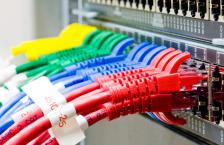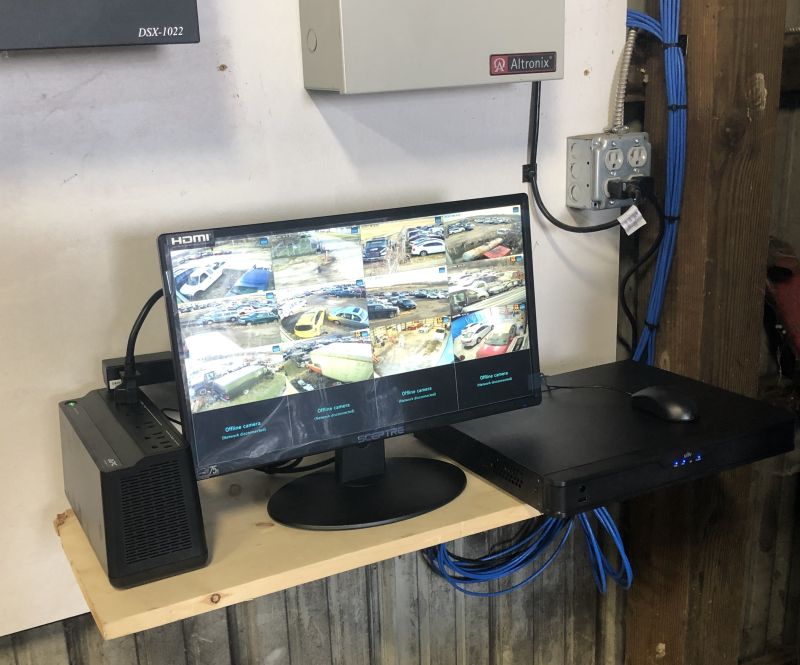Coaxial cables are a form of signal transmission cable that is used to pass electrical signals between devices, systems, or components. Whereas standard electrical cable consists of one or more wires through which an electrical current is passed (a flow of electrons), coaxial cable is used to pass radio frequency (RF) signals in the form of a transverse electromagnetic wave. The design of coaxial cable consists of an inner conductor surrounded by a dielectric layer, which is then enclosed in a cylindrical sandwich that contains additional layers of shielding as well as an outer protective jacket to prevent damage to the signal carrying components during installation or from environmental stresses. Coaxial cables are commonly used as transmission lines and can transmit high-frequency signals at low loss.
The common types of coaxial cable include:
Hard line coaxial cable
Flexible coaxial cable
Semi-rigid coaxial cable
Formable coaxial cable
Rigid coaxial cable
Twin axial cable
Triaxial cable
The terms coaxial cables and coaxial cable assemblies are often used synonymously, however, some references differentiate the two by defining the assembly to represent the cable material fitted with end connectors and available in standardized lengths for immediate delivery. In that context, a coaxial cable would represent bulk cable sold in spools or coils of say 100- or 500-foot lengths, to which cable connectors are fitted once the final cable length has been established.
Types of coaxial cable
In the sections below, a brief description of each of the types of coaxial cable is provided.
Hard line coaxial cable
Hard line coaxial cable makes use of a center conductor that is constructed out of materials such as copper, silver, aluminum, or steel and this type of cable is typically larger in diameter than other forms of coaxial cable. These types of cables may be used in high-strength signal transmission. Some forms of hard line make use of pressurized nitrogen as an inhibitor to moisture intrusion as well as to prevent arcing.
Flexible coaxial cable
As the name implies, flexible coaxial cable can move and flex as needed to suit the configuration and geometry of the application. A typical design for flexible coaxial cable utilizes a metal inner conductor surrounded by a flexible polymer that functions as the dielectric, with an outer jacket for protection from the environment. When there is a need to increase flexibility, the metal core conductor may be switched to a stranded design from a solid wire, and a polyethylene (PE) dielectric foam may be substituted for the more rigid dielectric material.
Flexible coaxial cable is the most common type of coaxial cable, familiar to anyone who has seen it in use for the connection of home video equipment and televisions.
Semi-rigid coaxial cable
Semi-rigid coaxial cable makes use of a solid copper outer sheath with a dielectric of PTFE. The copper sheath generally provides superior shielding effectiveness and the dielectric properties offer enhanced high frequency performance. By their design, this type of coaxial cable is not intended to be reformed or flexed after the initial forming operation has occurred.
Formable coaxial cable
An alternative to semi-rigid coaxial cable is formable coaxial cable, also known as conformable coaxial cable. In place of a rigid copper outer sheath, a flexible metal sheath is used, which can be reshaped and formed by hand the meet the desired cable configuration requiring any specialized tools. Formable coax is sometimes used to layout the design for cable placement in prototype applications, and once stabilized, the design is converted to make use of the semi-rigid coaxial cable.
Rigid coaxial cable
Rigid coaxial cable, sometimes called rigid line, consists of two concentrically mounted copper tubes that are supported at fixed intervals across the length of the cable using PTFE supports or disk insulators. Although it is called a rigid coaxial cable, the term rigid coaxial transmission line may be a more appropriate moniker given that cable is traditionally envisioned as being flexible or bendable. Rigid transmission lines are manufactured and sold in flanged straight sections of a given fixed length. As a result, a set of standard connectors or couplings, such as 45- or 90-degree elbows, are available to join the sections of transmission line together as needed. Specialized braces and springs are used as well to allow for the differential expansion and contraction of the inner and outer copper tubes used in the transmission line run.
Twinaxial cable
Twinaxial cables (also known as Twin axial or Twinax) have two central conductors contained in the core wit a single outer core and dielectric, instead of the traditional one conductor design of most coaxial cable types. Some advantages of twin axial cable are reduced cable loss, greater protection from ground loops and capacitive fields, and a reduction in low-frequency magnetic noise. These cables are best suited for use in low-frequency digital and video applications.
Triaxial cable
Triaxial cable, also called triax, are coaxial cables to which an additional copper braid has been added. This braid functions as a shield and is grounded, thus passing any ground loop currents or capacitive field noise away from the inner core conductive elements. Triaxial cable provides increased bandwidth and interference rejection, offers an improvement in signal-to-noise ratio over that of standard coaxial cable, and reduces cable losses and cable loading.
Other types of coaxial cable
A few other specialized types of coaxial cable include:
Coaxial Ribbon Cable Assemblies
Micro Coaxial Cable
High-frequency Coaxial Cable
High-temperature Coaxial Cable
Water-cooled Coaxial Cable
For specialized needs, there are also coaxial cable custom design and manufacturing services available.
How Coaxial Cable is Specified
The common specifications for coaxial cable include the following:
The cable type or RG type, (which stands for Radio Guide), now largely an obsolete reference given that the underlying standard which defined these terms is no longer an active document. RG-6 is a very common type used in home video applications.
The material for the inner core conductor, which may be bare copper, silver-coated copper, tinned copper, or aluminum/copper, to name a few choices.
The impedance of the cable. The most common values for impedance are 50, 52, 75, or 93 ohms.
The jacket material, which is used as the outer protective layer of the cable.
The key cable dimensions, which include length, outer diameter, and wire gauge.
The desired connector configuration, which includes both the desired gender as well as the specific connector style such as BNC, SMA, SMB, or N-type.
The minimum bend radius
The attenuation measured in dB per unit length of cable
The rated temperature for the cable
Summary
This article presented a brief summary of the common types of coaxial cable and the parameters that define how a coaxial cable is specified. For information on other products, consult our additional guides or visit the Thomas Supplier Discovery Platform to locate potential sources of supply or view details on specific products.
Sources:
https://www.ppc-online.com/blog/what-is-coaxial-cable-and-how-is-it-used
https://www.eriinc.com/catalog/transmission-line/rigid-coaxial-line/
https://www.eriinc.com
https://www.milestek.com/blog/index.php/2011/05/twinax-vs-triax-cables-benefits-and-differences/
https://customcable.ca/flexible-semi-rigid-rf-coax-cable-assemblies/
https://www.digikey.com/en/product-highlight/a/amphenol-rf-division/cable-connectors#lowloss
Other Cable Articles
Types of Cables
Other “Types of” Articles
Types of Crimpers – A ThomasNet Buying Guide
Types of Temperature Transmitters
Types of Sockets
Three Types of Medical Coatings
Types of Springs – A Thomas Buying Guide
Types of Safety Gloves
Types of Guardrails – A ThomasNet Buying Guide
Types of Sealing Equipment – A Thomas Buying Guide
Prototypes in Electronics, Computer Software, and Computer Engineering
Types of Power Brushes
Types of Electrical Power Supply Interference
Types of Trucks and Carts – A Thomas Buying Guide
Types of Aerospace Adhesives – A ThomasNet Buying Guide
Plastic Prototype Printed Circuit Boards
Types of Motor Starters
Types of Data Acquisition Systems – A ThomasNet Buying Guide
Types of Cleanrooms – A ThomasNet Buying Guide
Types of Thyristors – A ThomasNet Buying Guide
Types of Light Fixtures
Types of Insulation – A Thomas Buying Guide
More from Electrical & Power Generation






0